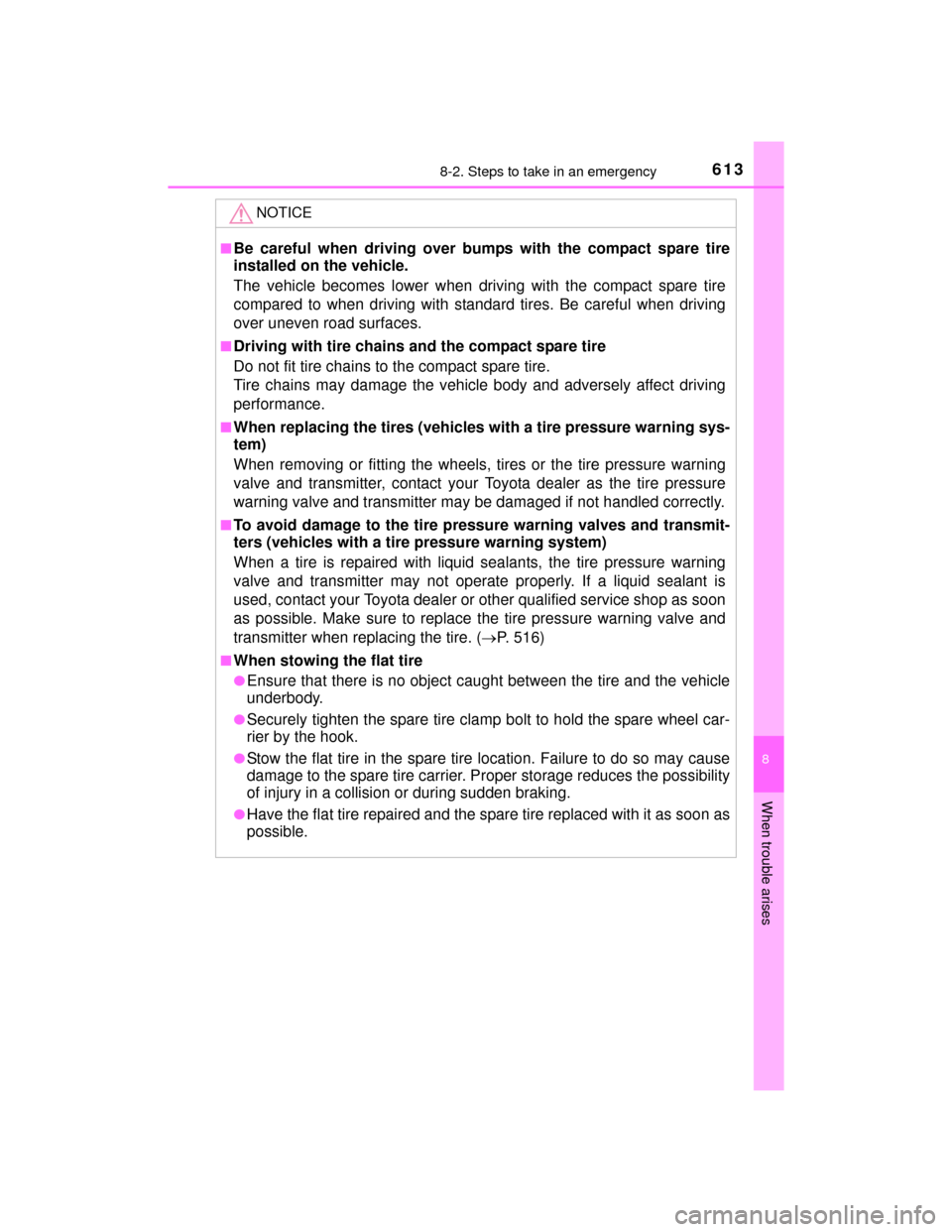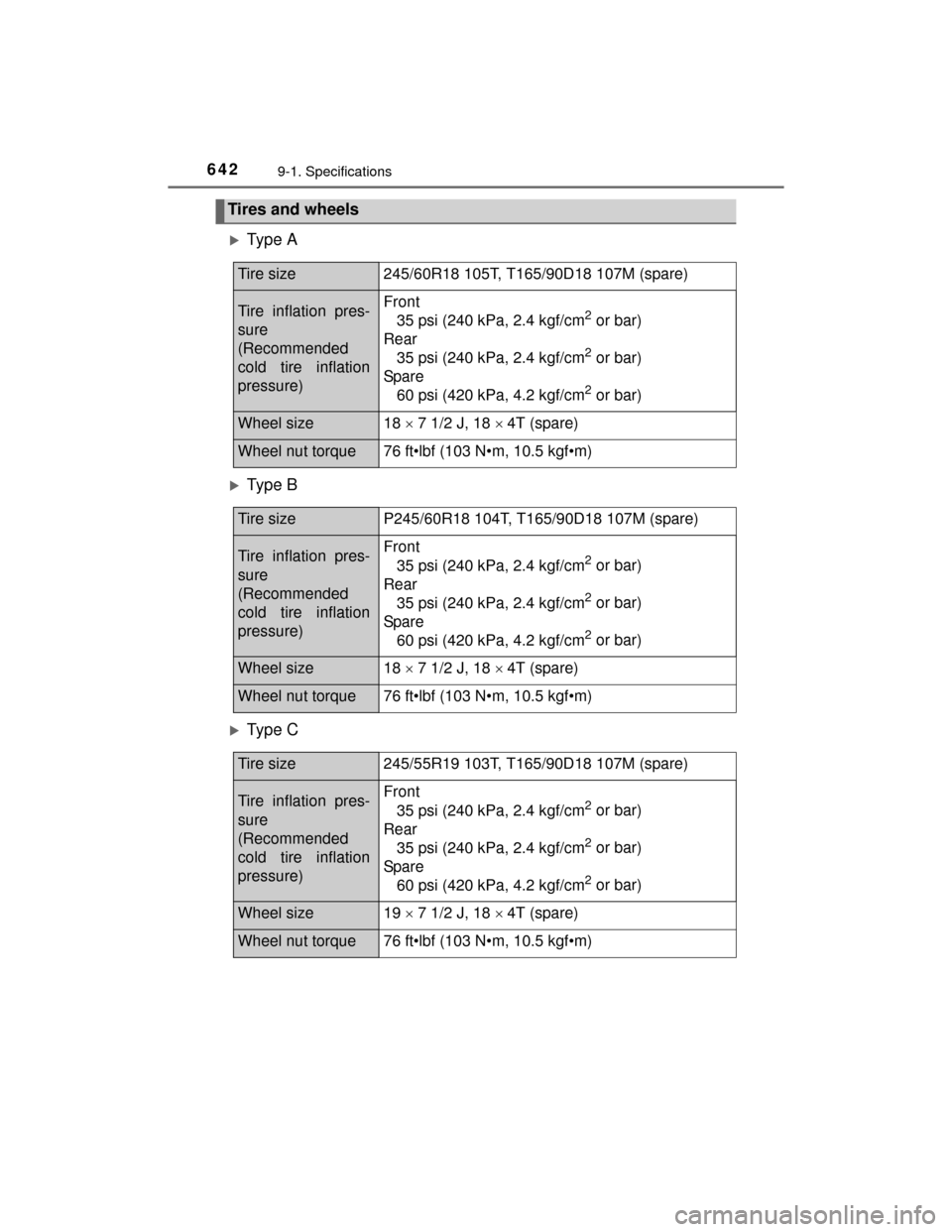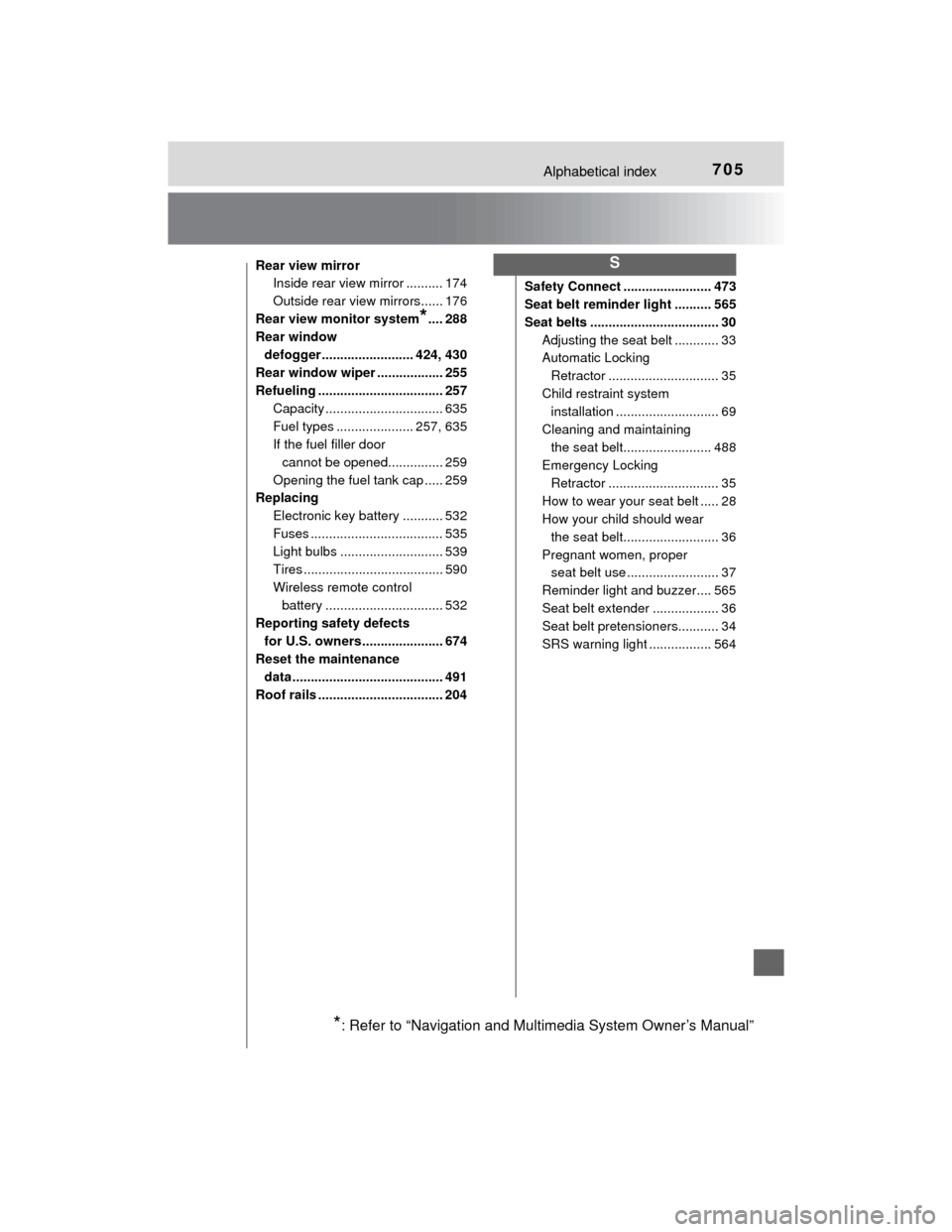Page 613 of 712

6138-2. Steps to take in an emergency
8
When trouble arises
HIGHLANDER_U (OM48A12U)
NOTICE
■Be careful when driving over bumps with the compact spare tire
installed on the vehicle.
The vehicle becomes lower when driving with the compact spare tire
compared to when driving with standard tires. Be careful when driving
over uneven road surfaces.
■Driving with tire chains and the compact spare tire
Do not fit tire chains to the compact spare tire.
Tire chains may damage the vehicle body and adversely affect driving
performance.
■When replacing the tires (vehicles with a tire pressure warning sys-
tem)
When removing or fitting the wheels, tires or the tire pressure warning
valve and transmitter, contact your Toyota dealer as the tire pressure
warning valve and transmitter may be damaged if not handled correctly.
■To avoid damage to the tire pressure warning valves and transmit-
ters (vehicles with a tire pressure warning system)
When a tire is repaired with liquid sealants, the tire pressure warning
valve and transmitter may not operate properly. If a liquid sealant is
used, contact your Toyota dealer or other qualified service shop as soon
as possible. Make sure to replace the tire pressure warning valve and
transmitter when replacing the tire. (P. 516)
■When stowing the flat tire
●Ensure that there is no object caught between the tire and the vehicle
underbody.
●Securely tighten the spare tire clamp bolt to hold the spare wheel car-
rier by the hook.
●Stow the flat tire in the spare tire location. Failure to do so may cause
damage to the spare tire carrier. Proper storage reduces the possibility
of injury in a collision or during sudden braking.
●Have the flat tire repaired and the spare tire replaced with it as soon as
possible.
Page 629 of 712
6298-2. Steps to take in an emergency
8
When trouble arises
HIGHLANDER_U (OM48A12U)
Stop the engine. Set the parking brake and shift the shift lever to P.
Remove the mud, snow or sand from around the front wheels.
Place wood, stones or some other material under the front wheels
to help provide traction.
Restart the engine.
AWD models: Activate all-wheel drive lock mode. (P. 297)
Shift the shift lever to D or R and release the parking brake. Then,
while exercising caution, depress the accelerator pedal.
■ When it is difficult to free the vehicle
If the vehicle becomes stuck
Carry out the following procedures if the tires spin or the vehicle
becomes stuck in mud, dirt or snow:
Press to turn off TRAC.
1
2
3
4
5
6
Page 642 of 712

6429-1. Specifications
HIGHLANDER_U (OM48A12U)
Type A
Type B
Type C
Tires and wheels
Tire size245/60R18 105T, T165/90D18 107M (spare)
Tire inflation pres-
sure
(Recommended
cold tire inflation
pressure)Front35 psi (240 kPa, 2.4 kgf/cm2 or bar)
Rear 35 psi (240 kPa, 2.4 kgf/cm
2 or bar)
Spare 60 psi (420 kPa, 4.2 kgf/cm
2 or bar)
Wheel size18 7 1/2 J, 18 4T (spare)
Wheel nut torque76 ft•lbf (103 N•m, 10.5 kgf•m)
Tire sizeP245/60R18 104T, T165/90D18 107M (spare)
Tire inflation pres-
sure
(Recommended
cold tire inflation
pressure)Front
35 psi (240 kPa, 2.4 kgf/cm2 or bar)
Rear 35 psi (240 kPa, 2.4 kgf/cm
2 or bar)
Spare 60 psi (420 kPa, 4.2 kgf/cm
2 or bar)
Wheel size18 7 1/2 J, 18 4T (spare)
Wheel nut torque76 ft•lbf (103 N•m, 10.5 kgf•m)
Tire size245/55R19 103T, T165/90D18 107M (spare)
Tire inflation pres-
sure
(Recommended
cold tire inflation
pressure)Front
35 psi (240 kPa, 2.4 kgf/cm2 or bar)
Rear 35 psi (240 kPa, 2.4 kgf/cm
2 or bar)
Spare 60 psi (420 kPa, 4.2 kgf/cm
2 or bar)
Wheel size19 7 1/2 J, 18 4T (spare)
Wheel nut torque76 ft•lbf (103 N•m, 10.5 kgf•m)
Page 644 of 712
6449-1. Specifications
HIGHLANDER_U (OM48A12U)
■When towing a trailer (245/55R19 103T tires)
On rear tires, add 1 psi (10.0 kPa, 0.1 kgf/cm
2 or bar) to the recom-
mended tire inflation pressure and drive at speeds below 65 mph (104
km/h).
Page 650 of 712

6509-1. Specifications
HIGHLANDER_U (OM48A12U)
Tire size ( P. 652)
DOT and Tire Identification Number (TIN) ( P. 651)
Location of treadwear indicators ( P. 515)
Tire ply composition and materials
Plies are layers of rubber-coated parallel cords. Cords are the strands
which form the plies in a tire.
Radial tires or bias-ply tires
A radial tire has “RADIAL” on the sidewall. A tire not marked “RADIAL”
is a bias-ply tire.
TUBELESS or TUBE TYPE
A tubeless tire does not have a tube and air is directly put into the tire.
A tube type tire has a tube inside the tire and the tube maintains the air
pressure.
Load limit at maximum cold tire inflation pressure ( P. 656)
Maximum cold tire inflation pressure ( P. 656)
This means the pressure to which a tire may be inflated.
Uniform tire quality grading
For details, see “Uniform Tire Quality Grading” that follows.
Summer tires or all season tires ( P. 519)
An all season tire has “M+S” on the sidewall. A tire not marked “M+S”
is a summer tire.
“TEMPORARY USE ONLY”
A compact spare tire is identified by the phrase “TEMPORARY USE
ONLY” molded on its sidewall. This tire is designed for temporary
emergency use only.
1
2
3
4
5
6
7
8
9
10
11
Page 654 of 712

6549-1. Specifications
HIGHLANDER_U (OM48A12U)
This information has been prepared in accordance with regulations
issued by the National Highway Traffic Safety Administration of the
U.S. Department of Transportation.
It provides the purchasers and/or prospective purchasers of Toyota
vehicles with information on uniform tire quality grading.
Your Toyota dealer will help answer any questions you may have as
you read this information.
■DOT quality grades
All passenger vehicle tires must conform to Federal Safety Require-
ments in addition to these grades. Quality grades can be found
where applicable on the tire sidewall between tread shoulder and
maximum section width.
For example: Treadwear 200 Traction AA Temperature A
■Treadwear
The treadwear grade is a comparative rating based on the wear
rate of the tire when tested under controlled conditions on a speci-
fied government test course.
For example, a tire graded 150 would wear one and a half (1 - 1/2)
times as well on the government course as a tire graded 100.
The relative performance of tires depends upon the actual condi-
tions of their use. Performance may differ significantly from the norm
due to variations in driving habits, service practices and differences
in road characteristics and climate.
■Traction AA, A, B, C
The traction grades, from highest to lowest, are AA, A, B and C,
and they represent the tire’s ability to stop on wet pavement as
measured under controlled conditions on specified government test
surfaces of asphalt and concrete.
A tire marked C may have poor traction performance.
Warning: The traction grade assigned to this tire is based on braking
(straight ahead) traction tests and does not include cornering (turn-
ing) traction.
Uniform Tire Quality Grading
Page 655 of 712

6559-1. Specifications
9
Vehicle specifications
HIGHLANDER_U (OM48A12U)■
Temperature A, B, C
The temperature grades are A (the highest), B, and C, representing
the tire’s resistance to the generation of heat and its ability to dissi-
pate heat when tested under controlled conditions on a specified
indoor laboratory test wheel.
Sustained high temperature can cause the material of the tire to
degenerate and reduce tire life, and excessive temperature can lead
to sudden tire failure.
Grade C corresponds to a level of performance which all passenger
car tires must meet under the Federal Motor Vehicle Safety Stan-
dard No. 109.
Grades B and A represent higher levels of performance on the labo-
ratory test wheel than the minimum required by law.
Warning: The temperature grades of a tire assume that it is properly
inflated and not overloaded.
Excessive speed, underinflation, or excessive loading, either sepa-
rately or in combination, can cause heat buildup and possible tire
failure.
Page 705 of 712

705Alphabetical index
HIGHLANDER_U (OM48A12U)
Rear view mirrorInside rear view mirror .......... 174
Outside rear view mirrors...... 176
Rear view monitor system
*.... 288
Rear window defogger......................... 424, 430
Rear window wiper .................. 255
Refueling .................................. 257 Capacity ................................ 635
Fuel types ..................... 257, 635
If the fuel filler door cannot be opened............... 259
Opening the fuel tank cap ..... 259
Replacing
Electronic key battery ........... 532
Fuses .................................... 535
Light bulbs ............................ 539
Tires ...................................... 590
Wireless remote control battery ................................ 532
Reporting safety defects for U.S. owners ...................... 674
Reset the maintenance data ......................................... 491
Roof rails .................................. 204 Safety Connect ........................ 473
Seat belt reminder light .......... 565
Seat belts ................................... 30
Adjusting the seat belt ............ 33
Automatic Locking Retractor .............................. 35
Child restraint system installation ............................ 69
Cleaning and maintaining the seat belt........................ 488
Emergency Locking
Retractor .............................. 35
How to wear your seat belt ..... 28
How your child should wear the seat belt.......................... 36
Pregnant women, proper seat belt use ......................... 37
Reminder light and buzzer.... 565
Seat belt extender .................. 36
Seat belt pretensioners........... 34
SRS warning light ................. 564
S
*: Refer to “Navigation and Multimedia System Owner’s Manual”